REVIEW OF THE DUCATI SCRAMBLER CROSS-E ELECTRIC SCOOTER
Written by Ed Wiles, Scootered Founder
Introduction
Ducati are of course known for their high performance motorbikes; but the Italian company have brought out a range of electric scooters, including several urban scooters (similar to the likes of Xiaomi). The Ducati Scrambler, however, is positioned somewhat differently, taking its name from the original Scrambler motorbikes, a series of off-roaders that first appeared in 1962. But is the Scrambler Cross-E just a marketing gimmick trading off its famous namesake, or does it provide a genuinely classy scooter? Let's take a look!
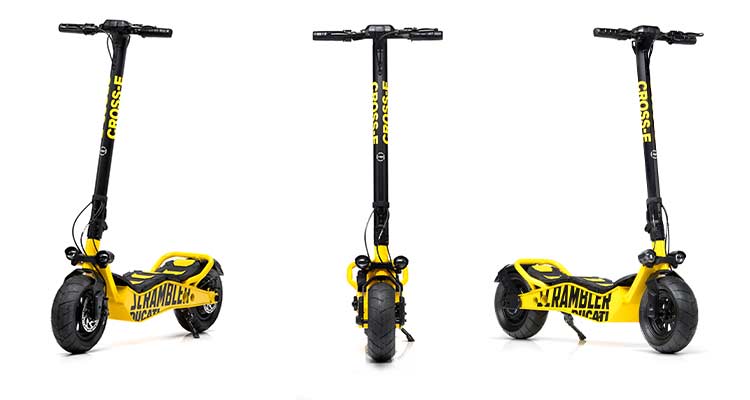
The Basics
The Ducati Scrambler Cross-E is a foldable electric scooter, currently the priciest in the Ducati range. It is not like anything else they offer, being designed (ostensibly) for off-roading (what one might commonly refer to as a "dirt bike"). The Scrambler retains the usual 25 km/h (16 mph) top speed (the speed most countries think e-scooters should be limited to), a 35 km range (though due to a clerical error by Ducati, this has often been misreported as 40 km), and a hefty 27 kg weight. The removable battery is housed in the base, while the dashboard displays an array of info. Like nearly all e-scooters, it requires some limited assembly out of the box.
The Design
If you don't like yellow, perhaps stop reading. The Scrambler Cross-E comes in just one colour in the UK and, alongside the black elements, is somewhat reminiscent of a wasp (or friendlier bee). Meanwhile, unlike Ducati's Pro range (such as the Pro II Evo and Pro III), the Ducati Scrambler uses a high strength steel alloy (instead of magnesium), which makes it more resistant to damage but does add some significant weight to the scooter. At 27 kg, the Scrambler is heavier than most privately-owned electric scooters (rental scooters tend to be heavier). So although one could use the Scrambler in an urban environment, it is not one that you could easily carry up steps.
The off-road nature of the Scrambler Cross-E continues with its 110/50-6.5” tyres, which were really designed to fit pocket dirt bikes. What the hell does 110/50-6.5" actually mean? Well, quite brilliantly, it is a mix of both metric and imperial units. So they are 110 mm (4 inches) wide, with an aspect ratio of 50% (meaning the tyre side is half its width), while the the 6.5 inches refers to the inner diameter (ie the wheel diameter); the outer diameter (which is how most e-scooter tyres are measured) is actually about 10.5 inches.
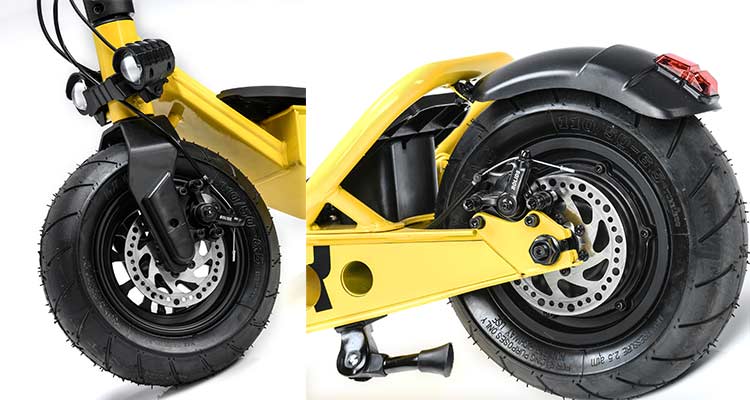
Beauty is in the eye of the beholder as someone once said. Was it Shakespeare? No, how sexist: it was Margaret Wolfe Hungerford. I am unaware of any scooters that look like the Ducati Scrambler and have to admit I quite like its boldness. However, I would want to show it off in an urban environment rather than the unpopulated countryside if I was spending £899. I think this goes to the heart of the issue: is the Scrambler really the e-scooter equivalent of a dirt bike or actually an off-roader that would mostly be used in an urban landscape.
This kind of dichotomy is seen in other forms of transport; especially cars. How many people that drive a Landrover are using it to traverse rocky fells? My late father drover a Landrover and it mostly functioned as a dog carrier. Increasing my suspicion that the Scrambler was designed with at least one eye on the concrete road is its lack of suspension. Of course, the relatively large tyres provide more cushioning than average e-scooter tyres, but I would expect suspension on a true off-roader.
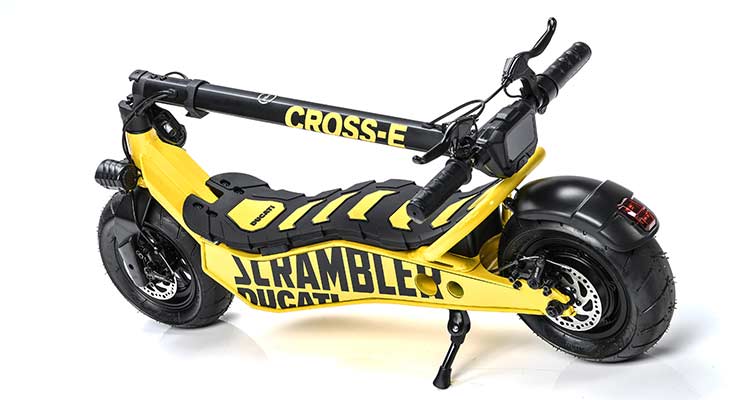
The display on the Scrambler Cross-E is the same as that on the Pro II Evo (see review for more), which is no bad thing. Pictured below, this 3.5 inch LED screen shows: (1) the current speed; (2) the battery level as indicated by the seven bars; (3) total distance traveled; (4) current trip distance; (5) headlight indicator; (6) which of the four modes is being used; (7) cruise control; (8) Bluetooth indicator.
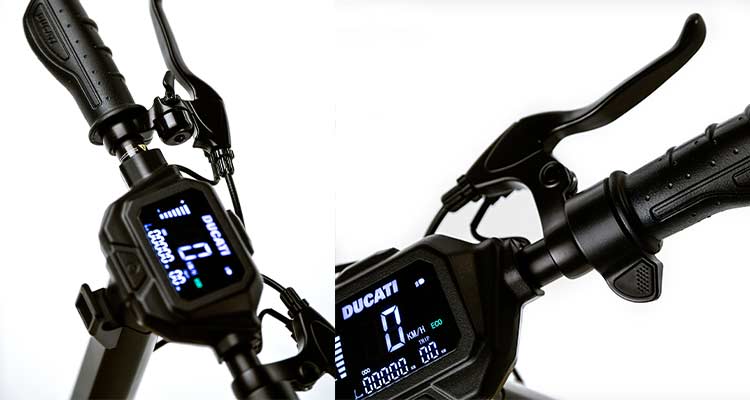
You may also notice in the image that the Pro III has two brake levers; which means that there is brake disk on the front wheel (controlled by the right lever) as well as the rear wheel (left lever). This is found in the Ducati Pro III as well, but is unusual in the wider world of electric scooters (which normally have a built-in electronic brake on the front wheel and is copied over from motorbikes.
The handlebar grips are moulded and branded, while the accelerator is the usual button on the right-hand side (though it is actually a different shape from those on the Ducati Pro range). In another divergence, the Scrambler has a two headlights instead of the usual one. This is reminiscent of the Jeep 2XE, but the purpose on the Ducati (other than aesthetic) is not known to me.
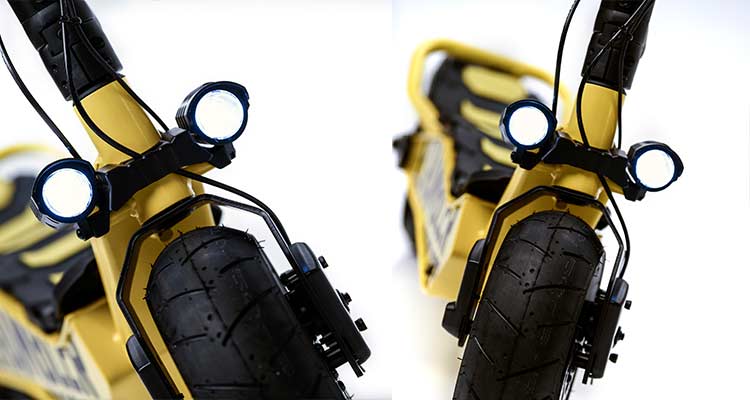
The battery in the Scrambler Cross-E is removable, which is unusual for e-scooters where the battery is housed in the base (some scooters, like the Decent X7, house interchangeable batteries in their stems). Because all batteries have a finite lifespan, the ability to remove a battery is definitely a bonus. Why the Scrambler is the only model currently with this ability is unclear.
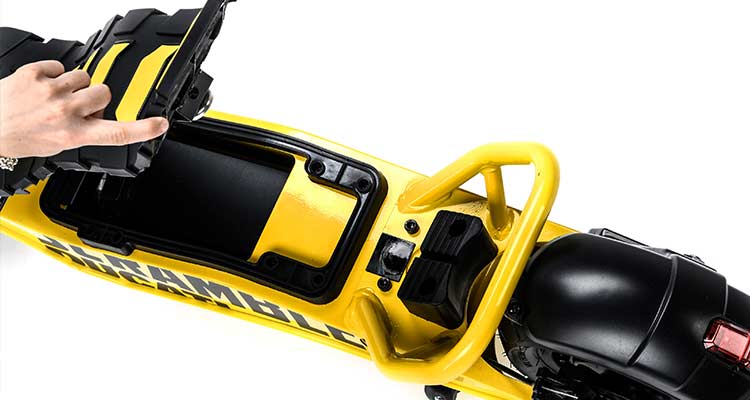
Riding The Ducati Pro III
So we come back to the question of where the Scrambler is really meant to be ridden. I have no experience of riding e-scooters (or any other vehicle) off-road so could not provide any meaningful insight into the Scrambler's rough terrain capabilities. But, as mentioned, I suspect that most buyers would really be using it on well-made roads. In this case, the tyres should make up for the lack of suspension.
Ducati does not provide braking distances but having two brakes is obviously going to give you more braking capacity. However, it's worth keeping in mind that using only the front brake while traveling at speed could cause you to "go over the handlebars" and damage those teeth you've spent so much time cleaning. Unless you are an experienced rider, I recommend relying mostly on the rear brake to slow down. Please take it easy to begin with if you are unused to riding e-scooters. We always recommend wearing a helmet too.
There are three riding modes: (1) ECO mode limits speed to 6 km/h; (2) DRIVE mode limits speed to 20 km/h; (3) SPORT mode limits the speed to 25 km/h. Of course, very few people ever use any mode apart from sport mode. Cruise control is available, which will save your thumb a bit if you are traveling a long distance. It's perhaps worth repeating that you may often read that the Scrambler's range is 40 km, but Ducati made a mistake in the literature they sent out. The Scrambler manual lists the correct data.
Battery & Motor
The Ducati Scrambler Cross-E comes with a 36 V, 10.4Ah battery providing 374 Wh, which is pretty good, but not stonking. The 35 km range is by no means bad, but at this price range you would perhaps expect something more. The rated motor power is 500 Watts, which is very good, and allows the Scrambler to take on hills that other scooters that most scooters (except the Jeep 2XE for example) would struggle with. As mentioned, the fact that the battery is removable should not be overlooked.
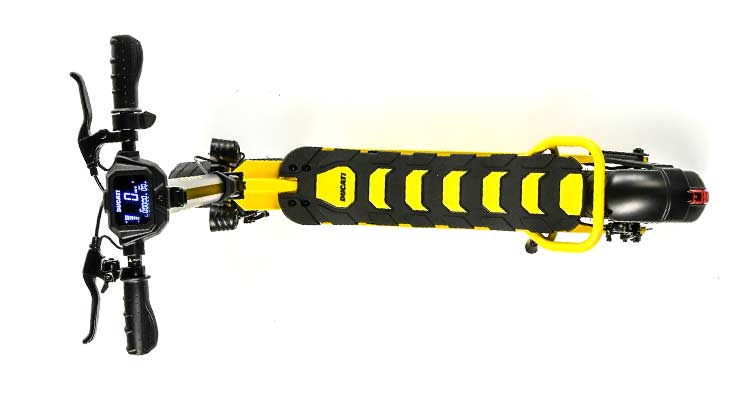
Summary
As I've intimated throughout, my main concern is that I am not sure the Scrambler Cross-E is (solely) an off-road vehicle: its lack of suspension would seem to be detrimental to cross-country riding. And yet its use of a steal alloy and its lack of app connectivity make it less useful for urban travel. It also seems that British riders cannot switch to MPH. I can imagine if you worked on a farm or something (ie a large space with differing terrain) then the Scrambler - or a fleet of Scramblers - could be the perfect fit. But when all is said and done, although you could argue there is nothing inherently wrong the Scrambler Cross-E, I find it difficult to give it a top rating because, depending on how you intend to you use it, it would seem to be missing something. Of course it depends on what you want to use it for, but I would personally opt for the Ducati Pro III or Jeep 2XE instead.
Rating
Specification Table
| Size (Unfolded) | 118 x 48 x 121 cm |
| Size (Folded) | 118 x 48 x 51 cm |
| Frame | Steel Alloy |
| Weight | 27 kg |
| Output | 500 watts |
| Top Speed | 25 km/h (15 mph) |
| Range | 35 km (22 miles) |
| Max Climbing Angle | 27 % (15 degrees) |
| Charge Time | 6 hours |
| Tyres | 10.5'' (4" wide) Tubeless |
| Shock Absorbers | Front |
| Front Brake | Disc |
| Rear Brake | Disc |
| Waterproof | IPX4: splash resistant |
| Lights | Front & Rear |
| Riding Modes | Eco/Drive/Sports |
| Display | Battery/Mode/Speed/Other |

